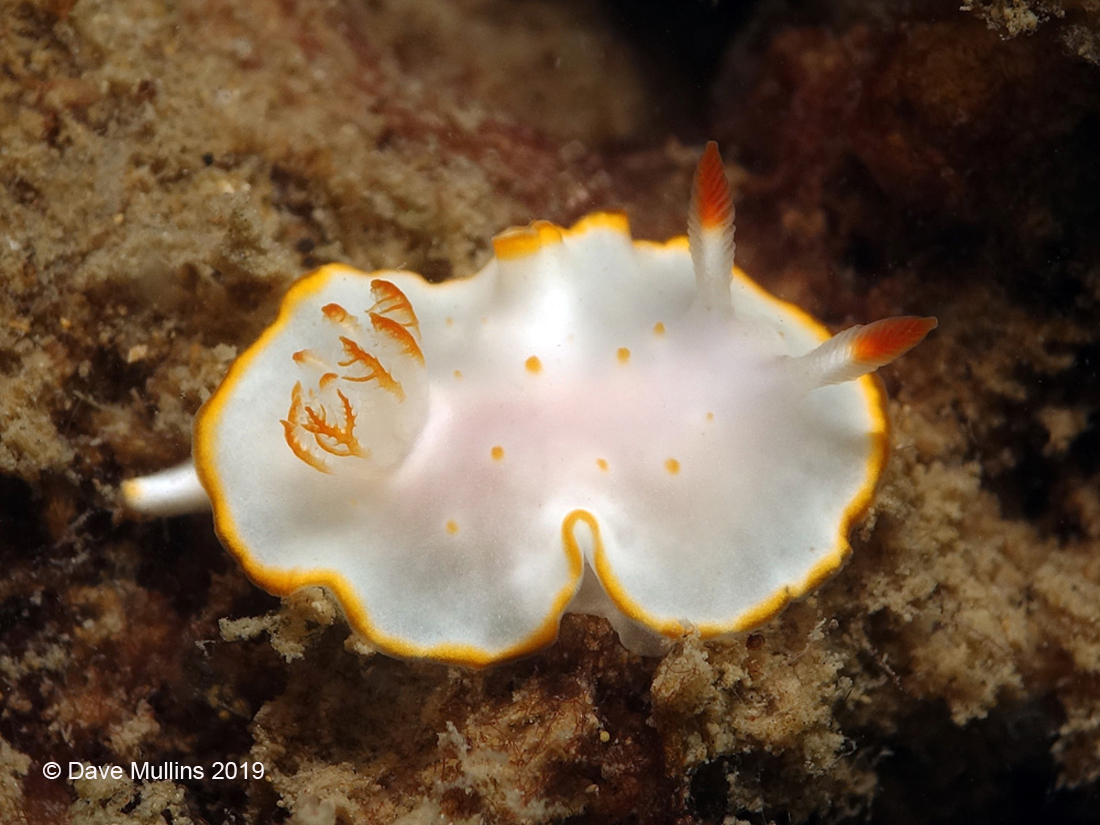 |
Diversidoris aurantionodulosa
Image courtesy of Dave Mullins
5 metres, Mooloolah River, Sunshine Coast, Queensland, Australia.
Sony DSC-RX100 in Nauticam Housing with wet macro diopter,
Diversidoris aurantionodulosa Rudman, 1987
Diversidoris is a small genus of cryptobranch dorids raised by Rudman in 1987. At that time it was monospecific, only containing the subject of this BOW - Diversidoris aurantionodulosa. This species is therefore, naturally, the type species of the genus. At the time Rudman commented: "At present this genus is monotypic but, .....further species may be found when the anatomy of more chromodorids is investigated." His new genus Diversodoris survived the molecular sequencing of Johnson & Gosliner in 2012 where much of the Chromodorididae family (and their relationships) was turned on its head. Among the changes in that review were the transfer of two species from Noumea (now Verconia) to Diversidoris by sampling results - Diversidoris crocea and Diversidoris flava, and also Diversidoris sulphurea by hypothesis.
Diversidoris aurantionodulosa is a small species up to 25 mm in length. The body shape is an elongated oval with a wide mantle having a number of distinct folds along each side. The foot is usually seen projecting past the posterior margin of the mantle and has an orange mark to the tip. The mantle carries a thin orange border with a narrow opaque white sub-marginal band with the rest being translucent white. There are slightly raised rounded white tubercles scattered over the mantle, some, or all, with an orange tip. The rhinophores are orange on the top half of the club with the remainder and the stalk being translucent white. The gills, that can retract into a pocket below the mantle (cryptobranch), are also translucent white with orange pigment on the outer edge of the main axes and some of the branching pinnae.
There are a number of slight colour variations reported including a creamy-yellow mantle, a mantle with a pink tinge centrally due to the underlying viscera showing through and some with a complete lack of orange tips to any of the white tubercles. Distribution is recorded from the Western Indian Ocean through to the Western Pacific Ocean.
The spawn of Diversidoris aurantionodulosa, laid on the substrate, is cream-white in colour and in the field was observed to be laid upright, on edge, as an anticlockwise spiral ribbon of one to two whorls. There is no extra-capsular yoke present. Larvae development is lecithotrophic.
Diversidoris aurantionodulosa feeds on certain sponges of the Darwinella genus.
References:
- Rudman,W.B. (1987) The Chromodorididae (Opisthobranchia : Mollusca) of the Indo-West Pacific: Chromodoris epicuria, C. aureopurpurea, C. annulata, C. coi and Risbecia tryoni colour groups. Zoological Journal of the Linnean Society, 90: 305-407.
- Wilson, N.G. (2002) Egg Masses of Chromodorid Nudibranchs (Mollusca: Gastropoda: Opisthobranchia). Malacologia, 2002, 44(2): 289-305.
- Rudman, W.B. & Bergquist (2007) A review of feeding specificity in the sponge-feeding Chromodorididae (Nudibranchia: Mollusca). Molluscan Research, 27(2): 60-88.
- Johnson, R.F., Gosliner, T.M. (2012). Traditional taxonomic groupings mask evolutionary history: A molecular phylogeny and new classification of the chromodorid nudibranchs. PLoS One 7 (4): e33479.
- This BOW has been modified from a previously published article in Dive Log Magazine's - Critter ID with NudiNotes Column, Issue: #371 (June 2019):12 by David A. Mullins
Dave Mullins
Queensland, Australia
September 2019
Send Dave email at marineimages@hotmail.com

Attention all you Sluggers, and you know who you are! The NSSI 2nd edition is now available in ebook PDF and book form . The hard back version will become available Nov. 1st. Both will cost $65 (individually). You will need to jump through a few hoops to get the electronic version as pdf distribution is protected by Adobe ID!! Please read the following to enable reading your electronic purchase! This new 2nd Edition is updated and reorganized, including 185 new species. Among other features, the new edition includes additional photographs of species, an identification key, and an up-to-date classification reflecting the latest evolutionary relationships. The Indo-Pacific represents the largest expanse of tropical ocean in the world, stretching from the Indian Ocean coast of southern Africa and the Red Sea to the central Pacific of the Hawaiian Islands, Easter Island and the Marquesas. This region supports the most diverse marine fauna of any place in the world for most groups of marine organisms. The nudibranchs and sea slugs are no exception to this rule; there are about 3,000 described species of these organisms in the world and at least 40% of these have been found exclusively in the Indo-Pacific tropics. This book illustrates 2,138 Indo-Pacific nudibranchs and sea slugs, including many undescribed species.
|

|
